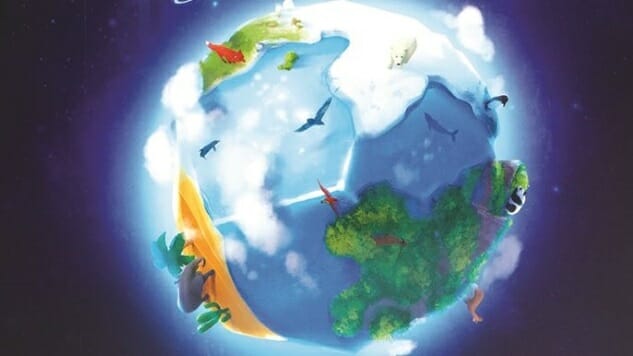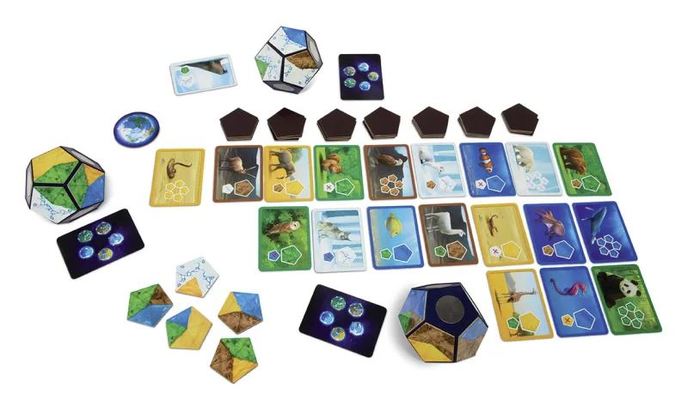The Board Game Planet Has Awesome Pieces but Not Enough Strategy
Images courtesy of Blue Orange Games. Games Reviews board games
Planet, released earlier this year by Blue Orange, particularly shines in its look and feel: Each player gets a 12-sided polyhedron and will attach magnets to all 12 sides over the course of the game as they build their planets for points. It’s a very quick game to learn and to play, even with four players, that lets you hold the whole world in your hands, although there isn’t much depth here and there are a lot of random elements beyond any one player’s control.
Designed by relative newcomer Urtis Šulinskas, Planet asks players to build their planets to make them more hospitable for various species that seek to live in the five basic habitat areas shown on the game pieces: desert, forest, mountain, water, and tundra. The game comes with 50 magnetic terrain tiles, each of which is a pentagon and contains five triangles showing three to five different terrain types on them. Each player is randomly assigned one terrain type, known only to themselves, for which they’ll score bonus points at game end. To start the game, the players shuffle all 50 tiles—by which I mean you throw them all on the table face-down, swoosh them around a lot, and then start ‘randomly’ grabbing stacks—and split them into 10 stacks of five, corresponding to rounds one through 10. The discards from those rounds will go to fill up the stacks, also five high, for rounds 11 and 12.
In a round, the stack is spread out on the table, and players go around the table choosing one tile to select and place somewhere on their planets—the polyhedrons I mentioned above, with the tiles and orbs both magnetic so the pieces go on and usually stay on (I’ve had one fall off mid-game, which isn’t great unless you know exactly which space it was on). For the first two rounds, that’s all you do.
Starting in round three, there will be animal cards for players to claim for game-end points, based mostly on the patterns they’ve created on their planets. You get an animal card if you meet the card’s criterion, which can be one of three types: The largest area of terrain type A that is adjacent (in at least one spot) to terrain type B; the largest area of terrain type A that is NOT adjacent to terrain type B (anywhere at all); or the most regions total of terrain type A, whether or not they’re contiguous. If one person has the most/largest, they get the card. If there’s a tie, or nobody qualifies at all, the card moves into the next round and will be up for grabs again.
The animal deck has 40 cards, but only half will be laid out in each game, so right out of the chute there’s a large luck or randomness component here. You score one point for animal cards that belong to your unique terrain type for that game, and two for all others, so if you have the tundra bonus card, but, say, only two of the 20 animal cards show tundra, you have a slight but clear advantage from the outset. Players can see all 20 animal cards at the start, so you can game-plan as you build out your planet, and the way the card criteria are distributed it’s very hard to get a majority of them or to get shut out (you’d have to actively try to never get a card, I think).
At the end of the game, players reveal their terrain bonus cards and count up all regions they had of their own unique types (meaning each little triangle, not each contiguous area). The bonuses range from two points to 10, but the number of areas you need to hit those bonuses vary a little bit by terrain type, based on their frequencies across all tiles. Winning scores for us ranged from 17 to the low 20s in all our games, with anywhere from two to four players. Pro tip: After the last round, take all of your tiles off your planet so you can easily count your terrain spaces, since it’s madness to try to count while they’re still on the orb.
The hook to Planet is absolutely the pieces themselves. You are, in effect, holding your board the entire game. The scoring is simple, and the way you calculate area sizes to figure out who gets cards, while not intuitive, isn’t too difficult for even novice players. I don’t know how much replay value there really is in Planet, however, since everyone will have the same basic strategy, just tailored to different terrain types, and there isn’t much variety in tiles or cards. You might play a few times to even out the luck in any one game’s draw, but beyond that it’s probably more for a family game night with the kids than for adults to break out and play on their own.
Keith Law is a senior baseball writer for ESPN.com and an analyst on ESPN’s Baseball Tonight. You can read his baseball content at search.espn.go.com/keith-law and his personal blog the dish, covering games, literature, and more, at meadowparty.com/blog.
